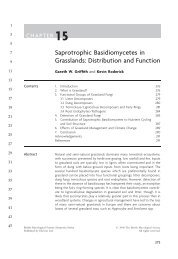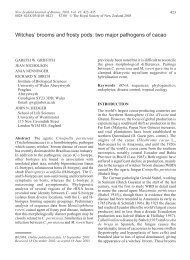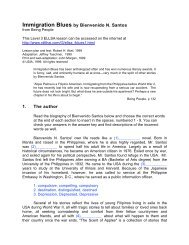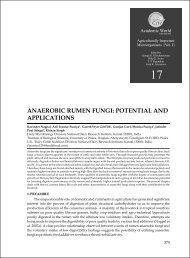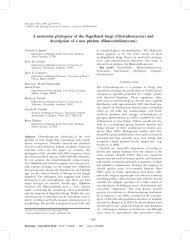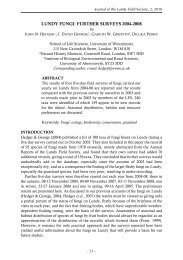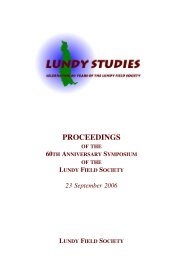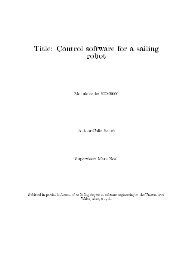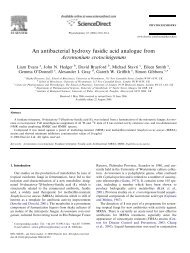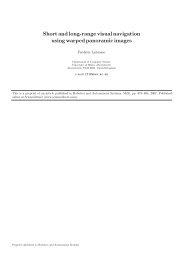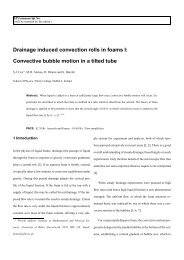Download the pdf - Users Site
Download the pdf - Users Site
Download the pdf - Users Site
You also want an ePaper? Increase the reach of your titles
YUMPU automatically turns print PDFs into web optimized ePapers that Google loves.
are often host-specific, but may form different spore types on two alternate hosts.<br />
The most productive time of year to survey <strong>the</strong>se fungi is in <strong>the</strong> late winter, spring<br />
and early summer and our own visits in April 2005 and January 2006 have greatly<br />
extended <strong>the</strong> records of <strong>the</strong>se fungi on Lundy, but many have yet to be found. One<br />
of <strong>the</strong> most obvious is Phragmidium violaceum which is common on bramble, Rubus<br />
fruticosus agg., as obvious purple spots on <strong>the</strong> upper leaf surface, below which<br />
yellow sporing structures (aecidia) are formed in <strong>the</strong> spring, followed by purple-black<br />
spore patches (telutosori) in summer and autumn. Puccinia smyrnii (Plate 13) can be<br />
easily found on leaves and stems of all <strong>the</strong> plants of <strong>the</strong> attractive yellow-flowered<br />
umbellifer, alexanders (Smyrnium olusatrum) in <strong>the</strong> lower Millcombe Valley. It<br />
forms pustules on which are yellow (aecidia) and later brown (uredosori) associated<br />
with deformed, swollen growth. Aecidia of Uromyces dactylidis (Plate 14) are of<br />
similar appearance on leaves of celandine (Ranunculus ficariae) also in Millcombe,<br />
whilst Uromyces muscari shows up as darker telutosori on <strong>the</strong> bluebell (Scilla nonscripta)<br />
leaves. Stinging nettles (Urtica dioica) infected by Puccinia caricina also<br />
show up in spring because of deformed growth of stems and leaves bearing bright<br />
orange aecidia. The spores from <strong>the</strong>se plants infect an alternate host, species of<br />
sedge, Carex, in nearby grassland, on which o<strong>the</strong>r spore types are formed. Walking<br />
along <strong>the</strong> east coast path <strong>the</strong> bright orange aecidia of Puccinia violae are obvious on<br />
leaves of <strong>the</strong> dog violet (Viola canina), accompanied by Puccinia umbilici, signalled<br />
by bright red spots on <strong>the</strong> leaf upper surface, with black telutosori below, on leaves<br />
of <strong>the</strong> wall pennywort (Umbilicus rupestris). Less obvious, and infrequently<br />
recorded, are <strong>the</strong> rusts on ferns, belonging to <strong>the</strong> genus Milesina, which form white<br />
uredospores in spring on <strong>the</strong> old over-wintering fronds. We recorded three species<br />
of <strong>the</strong>se rusts in our visit in January 2006: M. dieteliana was found on <strong>the</strong> clumps<br />
of common polypody (Polypodium vulgare) growing in <strong>the</strong> barn wall of Lundy<br />
Farm; on <strong>the</strong> clumps of ferns on <strong>the</strong> faces inside <strong>the</strong> Quarries we found M. kriegeriana<br />
on <strong>the</strong> broad buckler fern (Dryopteris dilatata); M. scolopendrii on leaves of <strong>the</strong><br />
harts tongue fern (Phyllitis scolopendrii).<br />
The smuts (Ustilaginales) are a group of plant pathogens related to <strong>the</strong> rusts, but<br />
which have yet to be recorded from Lundy. One example is Ustilago violacea, <strong>the</strong><br />
‘an<strong>the</strong>r smut’. On Lundy this would be expected on <strong>the</strong> sea campion (Silene<br />
maritima) and <strong>the</strong> red campion (S. dioica), where infected plants are only revealed<br />
by <strong>the</strong> replacement of pollen by purple brown masses of spores in <strong>the</strong> centre of <strong>the</strong><br />
flower - in addition female flowers are converted to male flowers. In April 2005, in<br />
spite of intensive searching of S. dioica plants in <strong>the</strong> Millcombe Valley and <strong>the</strong> east<br />
coast path, and a binocular search of <strong>the</strong> isolated flowering clumps of S. maritima<br />
on goat inaccessible ledges along <strong>the</strong> west and east coast, no infected plants were<br />
found. This is surprising, since U. violacea is very common on <strong>the</strong> two campions in<br />
very similar habitats on Skomer Island (Hedger, unpublished data). It is possible that<br />
this species, as well as <strong>the</strong> squill ‘an<strong>the</strong>r smut’ (Ustilago vaillentii) on spring squill<br />
(Scilla verna), also common on Skomer, will be found on Rat Island, which is <strong>the</strong><br />
only part of Lundy without significant grazing (Hubbard, 1997), and which would<br />
profit from a survey in April/May.<br />
- 150 -



